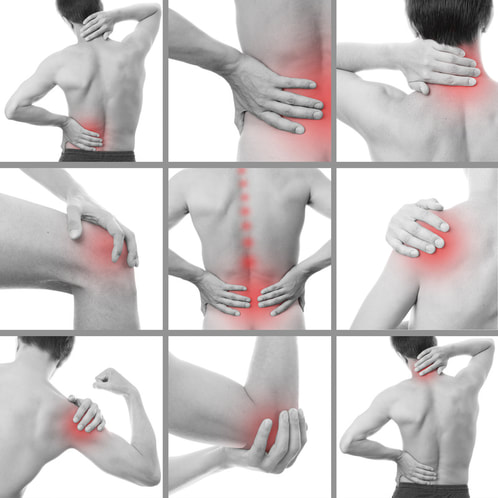Arthritic Pain

Osteoarthritis is a reactive process that occurs over a period of time, not an on/off switch. The end-stage result is loss of the friction reducing cartilage allowing bone on bone contact which is painful and creates secondary changes and inflammation within the joint.
There is a genetic link to some arthritis but there are almost always environmental and biomechanical factors to consider and modify.
Ideally, if we catch joint stiffness early and get treatment to alleviate it sooner rather than later and advice on how to prevent symptoms from progressing it can improve the management of the condition in the long run.
So, if pain has developed, act now!
If you are reading this, it is likely that you have been told (or think that you have) arthritis.
If you have, keep the following in mind-
- Just because a joint shows signs of arthritis on X-ray does not mean you will always get pain.
- Not all age related joint pain is from arthritis.
- Just because a joint is painful now, does not mean it always will be.
Although osteopathy cannot cure arthritis, it looks at the relationship between consecutive joints and treatment can often improve function above and below the damaged joint to decrease the pressure upon it.
The body can be a little like a car with the tracking out. You can still use it,but leave it for too long and you start seeing unusual wear patterns on the tyres. Very often correcting the cause will correct or alleviate the symptoms.
With damp and cooler weather, we always get an increase in the number of patients attending the clinic with joint aches and pains. The most common cause of these symptoms is osteoarthritis. In fact, more than 75 per cent of people over fifty-five show the joint changes of osteoarthritis somewhere in their body. Not all will experience symptoms.
As people near the age of retirement the opportunity for pursuing leisure activities, travel, family and other interests often increases and most people would agree that staying fit and active is essential for enjoying daily life. Usually by retirement, the body will have lost some of its elasticity and ability to adapt and will have experienced injuries and postural stress over the years resulting in stiffness and degenerative change.
It's never too late to see if we can help with your pain particularly as we are passionate about being able to try. So much so that,
if we can't help you, we will tell you (and won't charge you!)
What is Osteoarthritis?
Osteoarthritis is most common in the hip; knee, spine (spondylitis), ankle, feet and small joints of the hand. Symptoms include; pain, stiffness, crepitus or cracking joints and joint enlargement/swelling which may be experienced in more than one area. In these joints, the cartilage protects the end of the bones where they meet and provides a smooth, frictionless surface to allow movement. Each joint is surrounded by ligaments and a capsule which holds bone to bone and keeps the lubricating fluid inside the joint. Osteoarthritis is a wearing of the cartilage surface away from the contacting bony surfaces similar to brake pads on a car. Unlike brake pads, during the early stages of osteoarthritis the body has the ability to repair the cartilage. The new cartilage is thicker but more brittle. The damage to the cartilage starts a chain reaction involving all parts of the joint. The water tight capsule around the joint becomes thicker and less elastic producing stiffness. The inner lining of the joints, tendons and ligaments become inflamed resulting in swelling, heat, redness and pain after activity. Bony spurs or outgrowths may form around the edges of the joint making the joint appear enlarged, even the muscles around the joint lose strength due to under-use because of pain.
What causes Osteoarthritis?
Like any machine, a joint that is damaged and unbalanced wears out faster. People who consistently put heavy stress on the same joint are more likely to develop osteoarthritis, such as footballers’ hips and knees. On the other hand, lack of use of a particular joint does not allow it to be lubricated and repaired also leading to osteoarthritis. Other factors that may increase the chance of osteoarthritis are; being overweight, genetics, previous trauma and fracture(s) which can alter the joint movement.
Keeping Healthy
Here are some steps to help manage your symptoms:
- Walk at least 15 minutes a day to maintain muscle tone, lose weight and improve circulation.
- Take regular breaks whilst doing DIY, house work and gardening.
- A balanced diet low in refined sugars can help to decrease the production of inflammation
- Gentle stretching daily to help maintain tissue elasticity and maintain joint mobility.
- Research the latest advice on supplements such as Tumeric, Omega-3, glucosamine and chondroitin sulphate, apple cider vinegar etc. The evidence for their efficacy changes all the time but some have been shown to possibly improve joint health and reduce the symptoms experienced with osteoarthritis.
How can Osteopathy help?
As Osteopaths, we will first take a full case history so we can understand how the arthritis has developed. Some arthritis is not down to wear and tear and may require blood tests to determine the cause.
After a full examination and assessment we will be able to offer treatment and advice to help improve; mobility, circulation, function and to reduce joint pain and stiffness.
Cartilage in a joint takes its nutrition from the joint fluid. Joint lubrication comes from the imbibing of fluid from the joint capsule when you move the joint through its full range of motion. Once a joint is painful, you stop moving it through its full range of motion, you therefore no longer release the same degree of fluid between the joint surfaces, thus exacerbating the problem. Osteopaths mobilise your joints, rhythmically, safely and effectively beyond your physiological range of motion, thus restoring lubrication to the joint.
Treatment is usually gentle and aims to maintain the health of the joint and to ease the possibility of further damage. A combination of massage, muscle stretching and joint articulation may be used; together with advice on diet, lifestyle changes, footwear, insoles and exercises.
If you would like to book an appointment or find out if one of our experienced osteopaths can help, please call the clinic on:
01270 759491 or click the link below to BOOK ONLINE now.
THE CLINIC |
Osteopathy |
|
